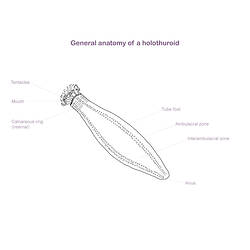General Description
Stout, elongate, Psolid-like body with upturned oral and anal ends and distinct narrow ventral sole; body mostly white with some darker grey flecking; 10 dendritic tentacles, ventral 2 smaller; very thick 'crystalline' body wall with close cover of small scattered tube feet used for attaching sand/grit; oval sole with wide bands of radial tube feet; body wall ossicles small multi-layered scales, thick knobbed perforated buttons, and shallow knobbed cups; sole ossicles large, shallow, knobbed cups and smaller multi-layered ossicles with knobs and secondary developments; up to ~40 mm long by 18 mm wide and 12 mm high (mid-body).
Apsolidium densum is distinguished from Apsolidium handrecki by colour (white not grey), much thicker body wall, ventral sole that is narrower than the width of the body, and various ossicle characteristics.
Biology
Apsolidium densum is a small, rarely seen, white species which has been found in the coastal rocky shallows of Victoria. The species name 'densum' is Latin for 'thick' and refers to its calcareous, crystalline body wall, which is also covered in small tube feet used to attach sand and detritus.
Apsolidium densum is a benthic suspension feeder, crawling along the rocky bottom on tube feet and feeding by extending its branching, tree-like tentacles into the surrounding water to collect organic particles. Sexes are known to be separate, but little else is known of the biology of this species. Despite extensive searching only a few specimens have been found and only at two locations - near Apollo Bay and at Flinders in Victoria.
Distribution
Australia, Victoria, at Apollo Bay and Flinders.
Habitat
Reefs/Coastal shores. Ocean rock platforms, to a depth of at least 2 m
More Information
-
Animal Type
-
Animal SubType
-
Fast Fact
The species name 'densum' is Latin for 'thick' in reference to the body wall.
-
Brief Id
Elongate body with upturned oral and anal extensions and distinct sole, white to off-white, thick crystalline body wall covered in tube feet and often grit, 10 feeding tentacles.
-
Maximum Size
4 cm
-
Habitats
-
Diet
Organic matter
-
Endemicity
-
Conservation Statuses
CITES: Not listed, FFG Threatened List: Endangered, EPBC Act 1999: Not listed, IUCN Red List: Not listed
-
Depths
Shore (0-1 m), Shallow (1-30 m)
-
Water Column Locations
On or near seafloor
-
Taxon Name
-
Scientific Author
O'Loughlin & O'Hara, 1992
-
Common Name
Sea Cucumber
-
Phylum
-
Class
-
Order
-
Family
-
Genus
-
Species Name
densum




